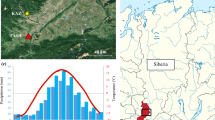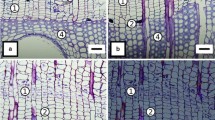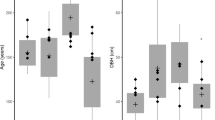Summary
The weekly increments under various conditions of a dozen of 30 to 60 years old Halep pines grown in the Lecce area have been measured during two years with a band dendrometer. The data have been compared with the X-ray density of a stem in radial direction, the weekly precipitations and the integrated temperature excess above 8°C. We have found thatgrowth rate behaviour is practically the same for all the pines considered. This indicate a strict dependence of growth on external factors such as climate and other environmental conditions. Vegetation activity does not seem to have regular dormancy periods: it stops when temperature and humidity become prohibitive and resumes as soon as they become favourable. The volume of wood formed in late-season (July–January) equals more or less that of early-season (February–June), whereas the wood mass and the number of cells in late-season is nearly double of that in early-season. During periods of high cambial activity one observes a lower cell lignification. However, on the whole, the photoperiodicity hypothesis in lignification seems to be confirmed. The growth rate appears inversely related to density. The lignification process appears to extend to the outer xylem layer of 1–2 mm and seems most effective during dry and warm seasons when cambial activity is low. Density wriggles appear to derive from combined variations of cambial activity, cell size and lignification, mostly corresponding to environmental events such as periods of drought or of cold weather. Finally, during the dry seasons we find that a precipitation event is generally followed within a time less than a week, by an increase of growth rate. Whereas during the wet season the growth rate variation is very similar to that of temperature excess.
Similar content being viewed by others
References
Bräker, O. U., 1981: Der Alterstrend bei Jahrringdichten und Jahrringbreiten von Nadelhölzern und sein Ausgleich. In: Radial growth in trees, IUFRO Symposium, Innsbruck Sept. 9–12, 1980, Vienna, 1981, 142/1, 75–102.
Brown, C. L., 1971: Secondary Growth, Growth Ring Formation. In:Trees Structure and Function, (M. H. Zimmermann and C. L. Brown, eds.) Berlin, Springer: 91–98.
Denne, M. P., Dodd, R. S., 1981: The Environmental Control of Xylem Differentiation. In:Xylem Cell Development (J. R. Barnet, ed.) London: Castle House Publication: 236–255.
Francini, E, 1953: Il pino d'Aleppo in Puglia.Annali Fac. Agr. Univ. Bari 8, 309–416.
Fritts, H. C., 1976:Tree Ring and Climate London: Academic Press 74–113.
Hughes, M. K., Kelly, P. M., Pilcher, J. R., La Marche Jr., V. C., eds., 1982:Climate from Tree Rings, London: Cambridge University Press: 223 pp.
Larson, P. R., 1964: Some indirect Effects of Environment on Wood Formation. In:The Formation of Wood in Forest Trees (M. H. Zimmermann, ed.). London, Academic Press: 345–361.
Lenz, O., Schaer, E., Schweingruber, F. H., 1976: Methodische Probleme bei der radiographische-densitometrischen Bestimmung der Dichte und der Jahrringbreiten von Holz,Holzforschung,30 (4), 114–123
Messeri, A., 1948: L'evoluzione della cerchia legnosa in Pinus halepensis Mill. in Bari,Nuovo Giornale Botanico Italiano LV (1), 111–132.
Müller, H. N., 1981: Messungen zur Beziehung Klimafaktoren — Jahrringwachstum von Nadelbaumarten verschiedener waldgrenznaher Standorte. In:Radial growth in trees. IUFRO Symposium, Innsbruck Sept. 9–12, 1980 Vienna, 1981, 142/2, 327–355.
Oppenheimer, H. R., 1945: Cambial wood production in stems of Pinus halepensis.Palestine Journal of Botany, Rehovot Series 2, 22–51.
Serre, F., 1976: Les rapports de la croissance et du climat chez le Pin d'Alep.Oecol. Plant,11, 143–171
Walter, H., Lieth, H., 1960:Klimadiagram Weltatlas Iena: Gustav Fischer Verlag.
Wardrop, A. B., 1981: Lignification and **logenesis. In:Xylem Cell Development, (Barnett J. R., ed.) Castle House Publications LTD, 120–127.
Author information
Authors and Affiliations
Additional information
With 6 Figures
Rights and permissions
About this article
Cite this article
Attolini, M.R., Calvani, F., Galli, M. et al. The relationship between climatic variables and wood structure in Pinus halepensis Mill.. Theor Appl Climatol 41, 121–127 (1990). https://doi.org/10.1007/BF00866435
Received:
Revised:
Issue Date:
DOI: https://doi.org/10.1007/BF00866435




